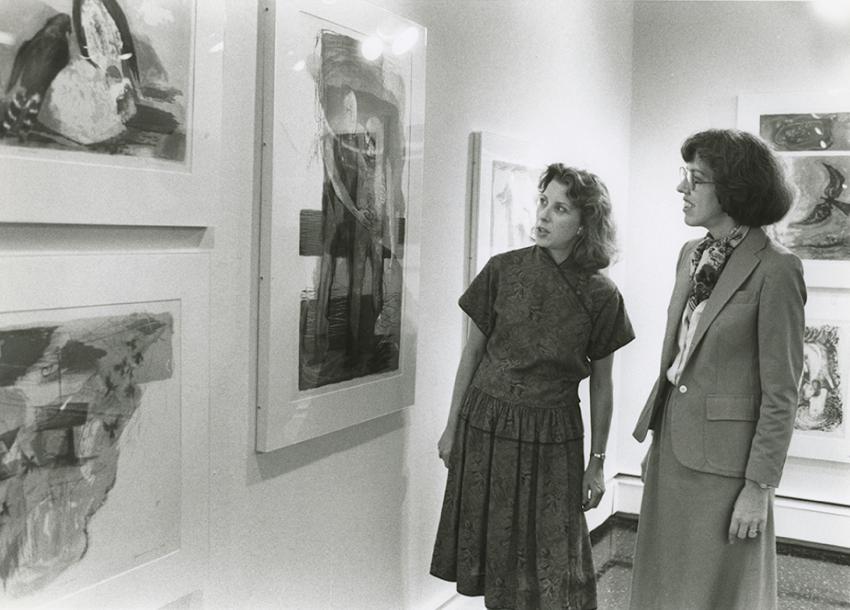In Memoriam: Zina Davis, first director of Beaver College Art Gallery

by Bonnie Hayes, assistant professor of Art History (1979-2017); director of the First-Year Seminar Program (1996-2017)
Zina Davis, the first official director of the Beaver College Art Gallery (which became the Arcadia University Art Gallery, now Arcadia Exhibitions) died on Aug. 18, 2020 at her home in New York City after a long illness. She was born on Oct. 6, 1943 in Providence, Rhode Island.
Davis earned a BFA from Beaver College in 1979, and completed her MFA in painting at the University of Pennsylvania. From 1979 to 1988, she served as Gallery Director at Beaver College. In 1988, Davis left to become director of the prestigious Joseloff Gallery at the University of Hartford/Hartford Art School, a position she held for over 20 years.
Davis inherited a strong and progressive exhibition program that was established in 1962 and managed by art department faculty members until her appointment in 1979. Davis expanded, molded, and transformed the Beaver College Art Gallery into a major cultural resource on campus. Her innovative, avant-garde, and provocative roster of contemporary art exhibitions engaged students, faculty, and staff. Among the distinguished exhibitions by major artists that Davis curated were solo shows by Elizabeth Murray, Alice Aycock, Barry Le Va, Arakawa, and William Wegmen. Davis championed the Gallery’s mission to “offer the public a unique opportunity to experience some of the most challenging art of our time in an intimate environment.” Davis believed that the Gallery should enrich and extend learning beyond the classroom. She provided an entry for students and faculty into the life-enhancing benefits of first-rate contemporary art by inviting the exhibiting artists to visit campus to discuss their work, and by frequently including students in the Gallery installation.
As Director, Davis highlighted the work of the art department faculty; Jack Davis’ paintings, Paula Winokur’s ceramics, Dennis Kuronen’s paintings, and Bob Mauro’s prints were part of annual faculty exhibitions that showcased their singular achievements in the arts and provided our visual arts students with inspiring role models.
Davis put great emphasis on the exhibition openings, which brought together the entire college community and alumni. Planning remarkable events that enhanced campus life reflected Davis’ joie de vivre. In 1981, Davis and I collaborated on a campus costume party for students and faculty in the Grey Towers Castle to celebrate the 100th anniversary of Picasso’s birth. Everyone came as a favorite figure in a Picasso painting. Dennis Kuronen, graphic artist and art department chair from 1988 to 1993, came costumed as Picasso’s Minotaur while Davis and I dared to be two of the female figures from Picasso’s Les Demoiselles D’Avignon!
One of Davis’ most significant accomplishments was the relocation of the original Fuller Gallery from the lower level of the college library to its current location in the Benton Spruance Art Center in 1985. This was a turning point that allowed a closer proximity to the art studios and classrooms in Spruance and Murphy Halls. This new gallery space, in the former power house, with its dramatically high ceilings, more comfortably accommodated the large scale of many contemporary works.
Davis’ influence on the direction of Arcadia Exhibitions remains vital to this day.
“Her exhibition legacy was critical to the success of the gallery,” said Richard Torchia, current Director of Arcadia Exhibitions. “As its first director, she continued the tradition of bringing significant and influential artists to campus begun in the 1970’s by art department faculty, while tempering this curatorial work with her own vision. Her efforts to support contemporary art on campus—and in Philadelphia—are now part of our DNA.”
Davis was a charismatic individual who had a natural ability to engage and befriend students, collectors, artists, and museum professionals. Her knowledge and enthusiasm for contemporary art was contagious. Her hospitality and generosity to all who knew her was exceptional. She will be missed by the Arcadia community, but her legacy and love for contemporary art lives on in the richness of Arcadia Exhibitions.


